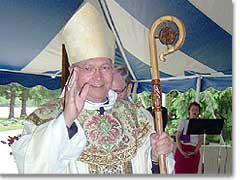 |
|
Mons. Robert Morlino, Madison, en la carpa donde se celebró la Misa en su visita al Santuario Schoenstatt Bishop Robert Morlino, Madison, in the tent where Mass was celebrated during his visit to the Schoenstatt Shrine Bischof Robert Morlino, Madison, in dem Zelt, in dem bei seinem Besuch beim Heiligtum die Messe stattfand |
|
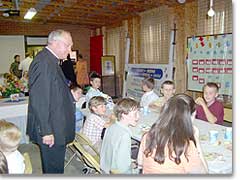 |
|
Mons. Morlino en el comedor de los chicos Bishop Morlino visiting the children's dining room. Bischof Morlino besucht die Kinder in ihrem Speisesaal |
|
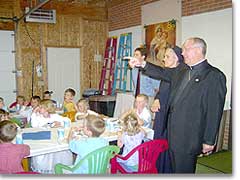 |
|
Jeff Brochtrup, dirigente de la diocesis, Hna. M. Victoria Heiderscheidt, con Mons. Morlino en su visita con los chicos Jeff Brochtrup, diocesan leader, Sr. M. Victoria Heiderscheidt, and Bishop Morlino visiting the children as they eat. Diözesanleiter Jeff Brochtrup und Schwester M. Victoria Heiderscheidt mit Bischof Morlino bei den Kindern |
|
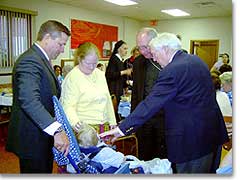 |
|
Mark y Fredericka Manning presentan Marko, su hijo discapacitado, al Obispo. A la derecha: Frank Shakespeare, el abuelo, ex-embajador en el Vaticano Mark and Fredricka Manning introduce Marko, their special
needs child, to Bishop Morlino. On the right is grandfather Frank Shakespeare,
former American ambassador to the Mark und Fredericka Manning stellen ihr behindertes Kind dem Bischof vor; rechts Frank Shakespeare, Großvater von Mark und früherer Botschafter im Vatikan |
|
 |
|
Procesión antes de la Misa The procession before Mass. Einzug zur Messe |
|
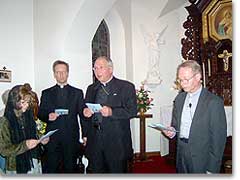 |
|
P. Jim Bartylla, director de la pastoral de vocaciones, Mons. Robert Morlino, y el P. Gerold Langsch, en el compromiso de la familia Fr. Jim Bartylla, Vocations Director; Bishop Robert Morlino and Fr. Gerold Langsch, Schoenstatt Father, as the Movement members promise their support to the bishop. Pfr. Jim Bartylla, Leiter der diözesanen Berufungspastoral, Bischof Robert Morlino und P. Gerald Langsch beim Versprechen der Schönstatt-Bewegung Fotos: Sr. M. Marcia Vinje © 2005 |
|
|
USA, Sr. M, Marcia Vinje. What a wonderful encounter! These are the words which spontaneously come to describe the visit of Bishop Robert C. Morlino to the Founder Shrine in Madison, Wisconsin, USA on Friday, June 3, 2005. Much work and dedication beforehand, plus graces from the Covenant Partner made for a joyful and fruitful encounter with the bishop. He came to meet Mary in her shrine and in the Schoenstatt family. For the Schoenstatt family it was an occasion to share the richness of their spirituality and to promise him our support in building the kingdom of the Father in the Diocese of Madison.
The evening opened with Holy Mass in a tent set up in front of the shrine. Besides Bishop Morlino concelebrants of the Mass included Father Gerold Langsch, regional superior of the Schoenstatt Fathers and director of the movement in Madison; Father Kent Schmitt, the local pastor who had met Father Kentenich during his years as a student in Queen of Apostles Seminary, Madison; Father Tait Schroeder, the parochial vicar of the parish; and Father Lawrence Kieffer, a retired priest who offers Mass four times a week in the shrine. The latter two often participate in Schoenstatt activities. They were assisted by Deacon Jack Fernan, also a Schoenstatt pilgrim. The bishop’s master of ceremonies, Father James Bartylla, is also the diocesan vocation director and all were happy that he would be learning more about Schoenstatt on this occasion. The sisters had "recruited" quite a number of young acolytes and First Communicants to give them an opportunity to experience the bishop close at hand.
This Covenant, Lord, is my song…
It was the feast of the Sacred Heart of Jesus. In his homily Bishop Morlino made the connection between the love for the heart of Jesus and the Eucharist. He spoke about reverence for the Eucharist and the need for adoration in order to deepen the personal connection with Our Lord. This in turn leads to greater attention at Holy Mass and love for the Eucharist. As a communion meditation three young women of the Chilean Schoenstatt family (Nati Romanini, Carito Inzunza, and Trini Vergara who are doing Schoenstatt missionary work at the state university in Madison) sang a beautiful song about the covenant. Then Father Langsch had an opportunity to welcome the bishop on behalf of the Schoenstatt family and the bishop gratefully acknowledged his warm words. On his way out of the tent, as when he came in, Bishop Morlino stopped to greet children and young people, genuinely enjoying the many young families.
First visiting the children
The kitchen crew had prepared a light but delicious supper. Since the dining room of the Schoenstatt Center is too small for the 200 guests, the older children ate in the adjoining garage with more "child-friendly" food. The bishop went there first to mingle with the youth and give them all the time they wanted. Table cloths, candles, and flowers set an elegant atmosphere. The Blessed Mother herself had arranged for dozens of free roses. Assigned seating strategically placed seasoned Schoenstatt members with the visiting priests and people who were interested in joining Schoenstatt groups.
The bishop was relaxed and talkative, sharing stories of seminary years with the Jesuits, and experiences in Rome. He shared anecdotes about the popes and how excited seminarians in Rome are about Pope Benedict XVI.
How Schoenstatt has touched my life
After the meal it was time to share with the bishop about Schoenstatt. The program began with the diocesan leaders, Jeff and Barb Brochtrup, introducing key people: the priests and sisters, Mr. Frank Shakespeare who is the former ambassador to the Vatican, seminarians, lay leaders, and various groups, e.g. the Schoenstatt Rosary Campaign Committee, the pioneer members of the movement, and those who participate in adoration. The university students had prepared a power point presentation on Schoenstatt as a place, a movement, and a spirituality. Four people then gave presentations on how Schoenstatt has touched their lives.
Sue Vanderscheuren, who has been in Schoenstatt since her youth, spoke about the effect of the home shrine on her family. In the past year all five of their children have made their covenant of love, including the five and six year old boys who asked on their own after watching the example of their older siblings. Sue also presented copies of the home shrine prayer and an explanation of their family home shrine symbols to the bishop.
Dawn Helt told about the Schoenstatt Rosary Campaign, giving some history as well as personal experiences of the power of Mary’s visits. Jim Raskob, who helps to coordinate the adoration for the 18th of each month, shared about its history at the Founder Shrine and how this prayer impacts his family. Tony and Kelly Butler gave a joint presentation on how they have seen the pilgrimage graces from the Schoenstatt shrine become effective in their lives.
How Schoenstatt can help in the bishop’s mission in the diocese
Bishop Morlino was then invited to share his impressions and how the Schoenstatt family could help him in his mission for the diocese. Bishop Morlino gave a clear and practical program for the future.
His first response was that he was very moved by the testimonies. All should continue to live their call to holiness and our concern for heaven. When Mary is the heart of a home she is there as the Immaculate Conception, as the Mother of Sorrows, and as the woman assumed into heaven. She is involved in all aspects of our lives.
In his experience with college students he would tell them that marriage means you work hard all day, go home, and don’t do anything you want, and yet enjoy it. So it is in our families. Only Jesus can give us the grace to find joy in sacrifice. He advised the Schoenstatt members to keep their eyes fixed on Jesus and keep Mary as the center of their homes. When things go wrong they should give thanks because they realize this life on earth is not heaven. It keeps us focused above. This should also be applied to life in the Church for things also go wrong there.
Assuring them that he is behind the Schoenstatt family in what they do, he reminded them that we all have a call to apostolic service from our baptism. This helps him as bishop not only because it inspires him, but also because it helps him with his mission. He constantly reminds himself that he is not the Messiah; he cannot do everything. Therefore he is grateful if we help along by doing our part.
Promote reverent worship in Eucharist worship – Promote vocations
Then the bishop made two specific requests. The first is to find ways to promote reverent worship in Eucharistic adoration and to build the number of people who have a sense of reverence before the Eucharist. We should ask ourselves how we can contribute to the stream of Eucharistic adoration in the diocese, including perpetual adoration. He remarked that this does not mean perpetual adoration in the shrine however. The solution should not be a quick fix that begins energetically but then fades away. Rather we should take time to plan well for a long-range goal. The bishop requested that we think and pray, then brainstorm together. In three to six months he would like to hear our plan.
The second commission is to promote vocations for women to the consecrated life. As bishop he is able to work for priestly vocations but he admitted he does not know how to speak with young woman about the topic. This task is connected with healthy family life and the example and counsel of good women. He pointed out that he did not intend this admonition only for the sisters but for the movement as a whole. We should recruit new people to help in these endeavors and not just further burden those who are already active. He repeated that he would like to hear from us in three to six months.
A spiritual gift for the bishop
After these remarks the bishop invited the audience to ask any question of their bishop. Subjects touched on embryonic stem cell research (a specialty of the bishop), the plans for rebuilding the cathedral (in March a fire destroyed it), and how to relate to parish priests. The interchange throughout was informal and relaxed, although Bishop Morlino is clear and precise in his teaching.
The Schoenstatt family then presented Bishop Morlino with gifts. First came a spiritual bouquet which delighted him as one could tell as he read its contents aloud: 328 Masses, 434 Rosaries, 133 Hours of adoration, 172 Visits to the shrine, 587 prayers of Consecration to Mary and 12 days of fasting. With a twinkle in his eye and a touch of humor he teased about the low number in regard to fasting. He said he would send his master of ceremonies to speak about fasting; it obviously was not his own strong point either. He was also given an MTA picture and a unity cross which he said would be placed on the altar in his private chapel.
The last event of the evening was a closing prayer in the shrine. As the people gathered Father Langsch had the opportunity to explain to Bishop Morlino privately the shrine symbols. The Schoenstatt family had chosen to renew with him the promises which Father Kentenich had made to the leaders of the Church during his life according to the formulation which the Schoenstatt family used with Pope John Paul II on September 20, 1985, in Rome. With the small children sitting on the floor at his feet they promised their support to the bishop. A final blessing closed the evening.
Everyone could sense that this introductory evening with the bishop is but the beginning of a warm relationship. The Schoenstatt family felt his confidence in them and his hope that they will live up to the legacy of the Dilexit Ecclesiam. As a man of deep prayer and one who prides himself in proclaiming the truth lovingly, Bishop Morlino seems to fit well in the Schoenstatt world!